MGT501: Analysis of Internal and External Stakeholders for 7-Eleven
VerifiedAdded on 2022/12/27
|16
|3801
|30
Report
AI Summary
This report provides a comprehensive stakeholder analysis of 7-Eleven, a Japan-based convenience store chain operating internationally. The report begins with an executive summary and introduction, outlining the importance of stakeholder engagement in business operations. It then delves into the background of 7-Eleven, identifying its functional areas and classifying its stakeholders into internal (employees, directors, and owners) and external (customers, business partners, and community) groups. The analysis explores the nature and degree of each stakeholder's interests, highlighting potential conflicts that may arise, and assesses their level of influence through a stakeholder matrix. The report also compares 7-Eleven's industry with its competitors and concludes with a summary of findings.
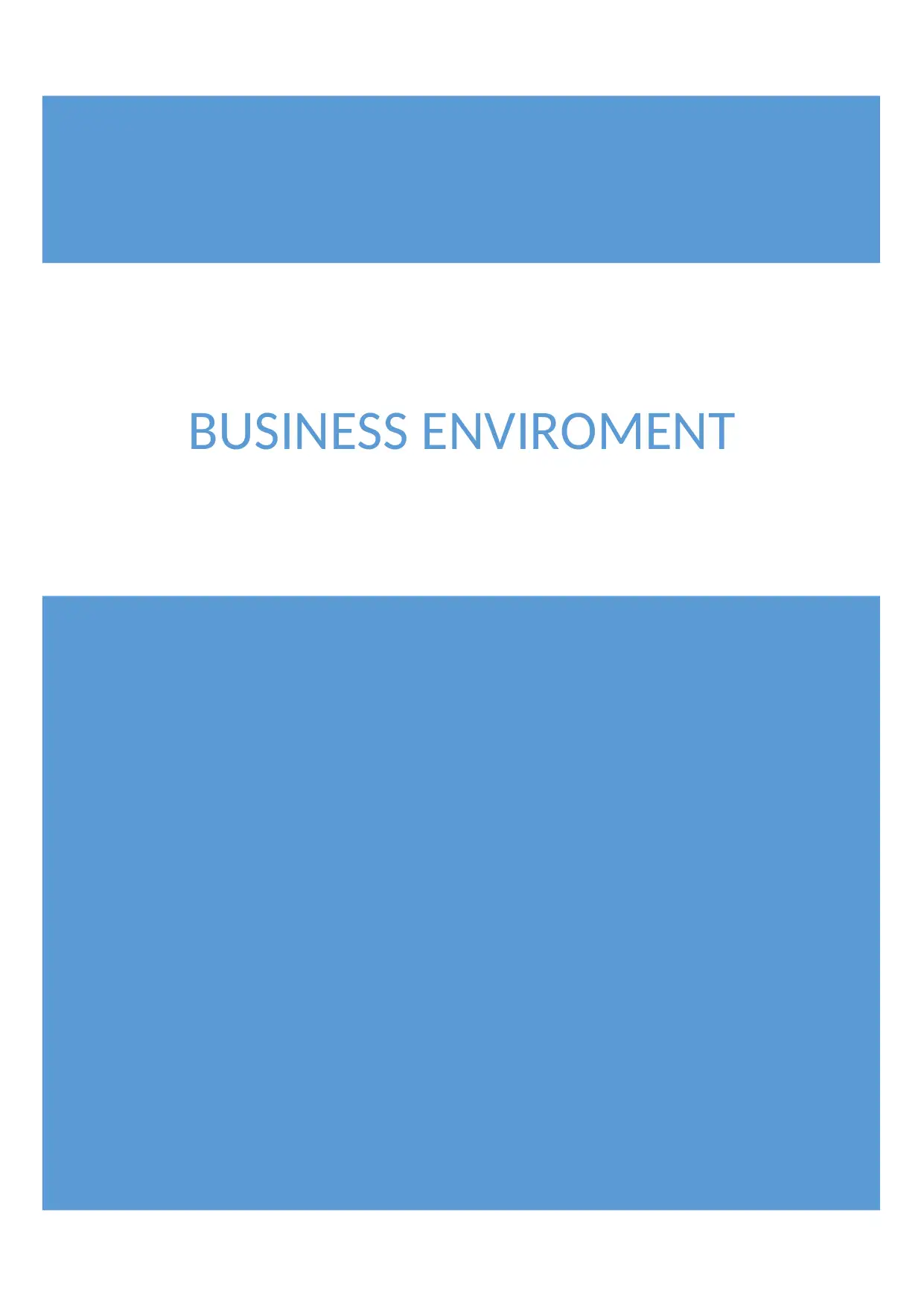
BUSINESS ENVIROMENT
Paraphrase This Document
Need a fresh take? Get an instant paraphrase of this document with our AI Paraphraser
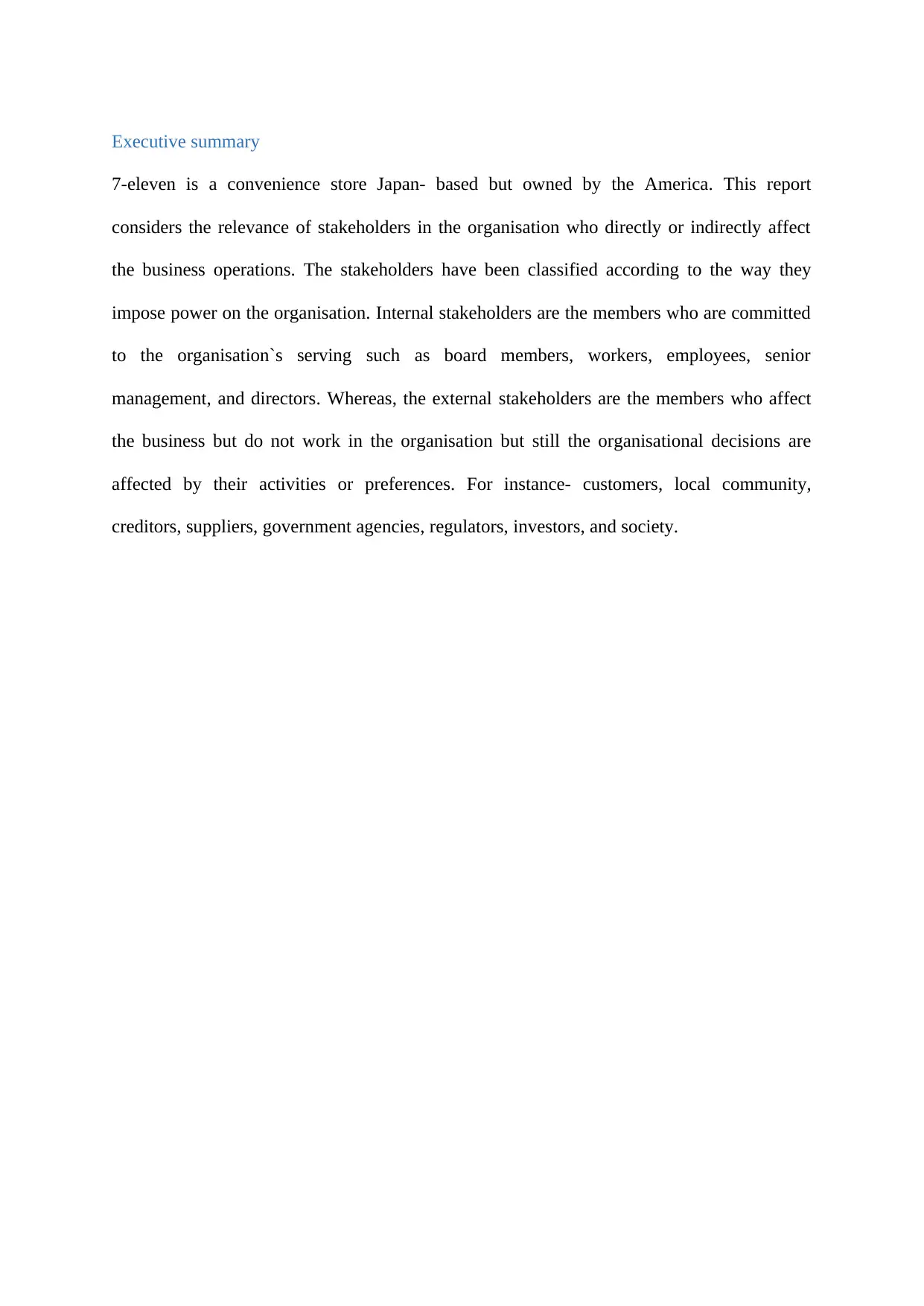
Executive summary
7-eleven is a convenience store Japan- based but owned by the America. This report
considers the relevance of stakeholders in the organisation who directly or indirectly affect
the business operations. The stakeholders have been classified according to the way they
impose power on the organisation. Internal stakeholders are the members who are committed
to the organisation`s serving such as board members, workers, employees, senior
management, and directors. Whereas, the external stakeholders are the members who affect
the business but do not work in the organisation but still the organisational decisions are
affected by their activities or preferences. For instance- customers, local community,
creditors, suppliers, government agencies, regulators, investors, and society.
7-eleven is a convenience store Japan- based but owned by the America. This report
considers the relevance of stakeholders in the organisation who directly or indirectly affect
the business operations. The stakeholders have been classified according to the way they
impose power on the organisation. Internal stakeholders are the members who are committed
to the organisation`s serving such as board members, workers, employees, senior
management, and directors. Whereas, the external stakeholders are the members who affect
the business but do not work in the organisation but still the organisational decisions are
affected by their activities or preferences. For instance- customers, local community,
creditors, suppliers, government agencies, regulators, investors, and society.
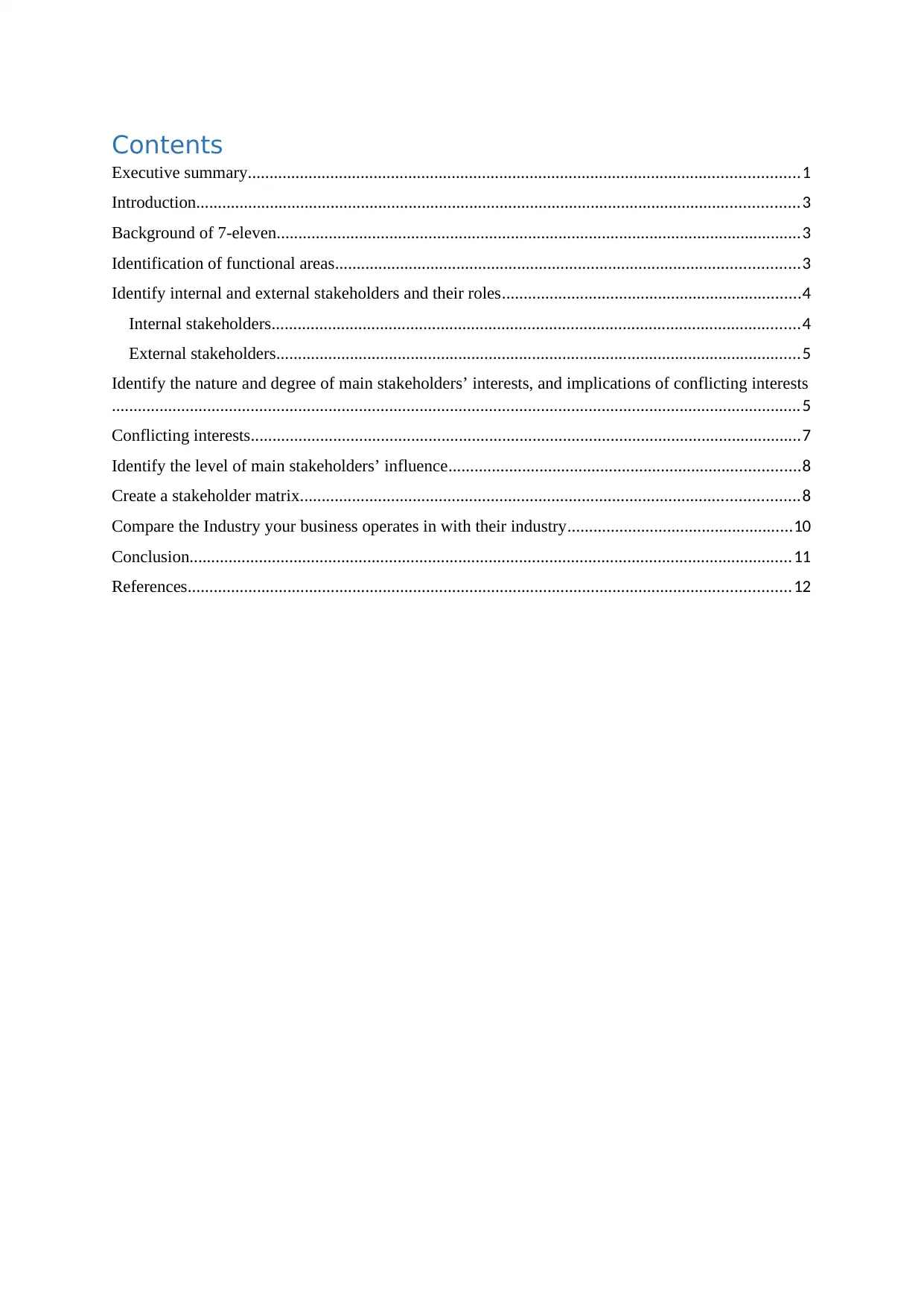
Contents
Executive summary...............................................................................................................................1
Introduction...........................................................................................................................................3
Background of 7-eleven.........................................................................................................................3
Identification of functional areas...........................................................................................................3
Identify internal and external stakeholders and their roles.....................................................................4
Internal stakeholders..........................................................................................................................4
External stakeholders.........................................................................................................................5
Identify the nature and degree of main stakeholders’ interests, and implications of conflicting interests
...............................................................................................................................................................5
Conflicting interests...............................................................................................................................7
Identify the level of main stakeholders’ influence.................................................................................8
Create a stakeholder matrix...................................................................................................................8
Compare the Industry your business operates in with their industry....................................................10
Conclusion...........................................................................................................................................11
References...........................................................................................................................................12
Executive summary...............................................................................................................................1
Introduction...........................................................................................................................................3
Background of 7-eleven.........................................................................................................................3
Identification of functional areas...........................................................................................................3
Identify internal and external stakeholders and their roles.....................................................................4
Internal stakeholders..........................................................................................................................4
External stakeholders.........................................................................................................................5
Identify the nature and degree of main stakeholders’ interests, and implications of conflicting interests
...............................................................................................................................................................5
Conflicting interests...............................................................................................................................7
Identify the level of main stakeholders’ influence.................................................................................8
Create a stakeholder matrix...................................................................................................................8
Compare the Industry your business operates in with their industry....................................................10
Conclusion...........................................................................................................................................11
References...........................................................................................................................................12
⊘ This is a preview!⊘
Do you want full access?
Subscribe today to unlock all pages.

Trusted by 1+ million students worldwide
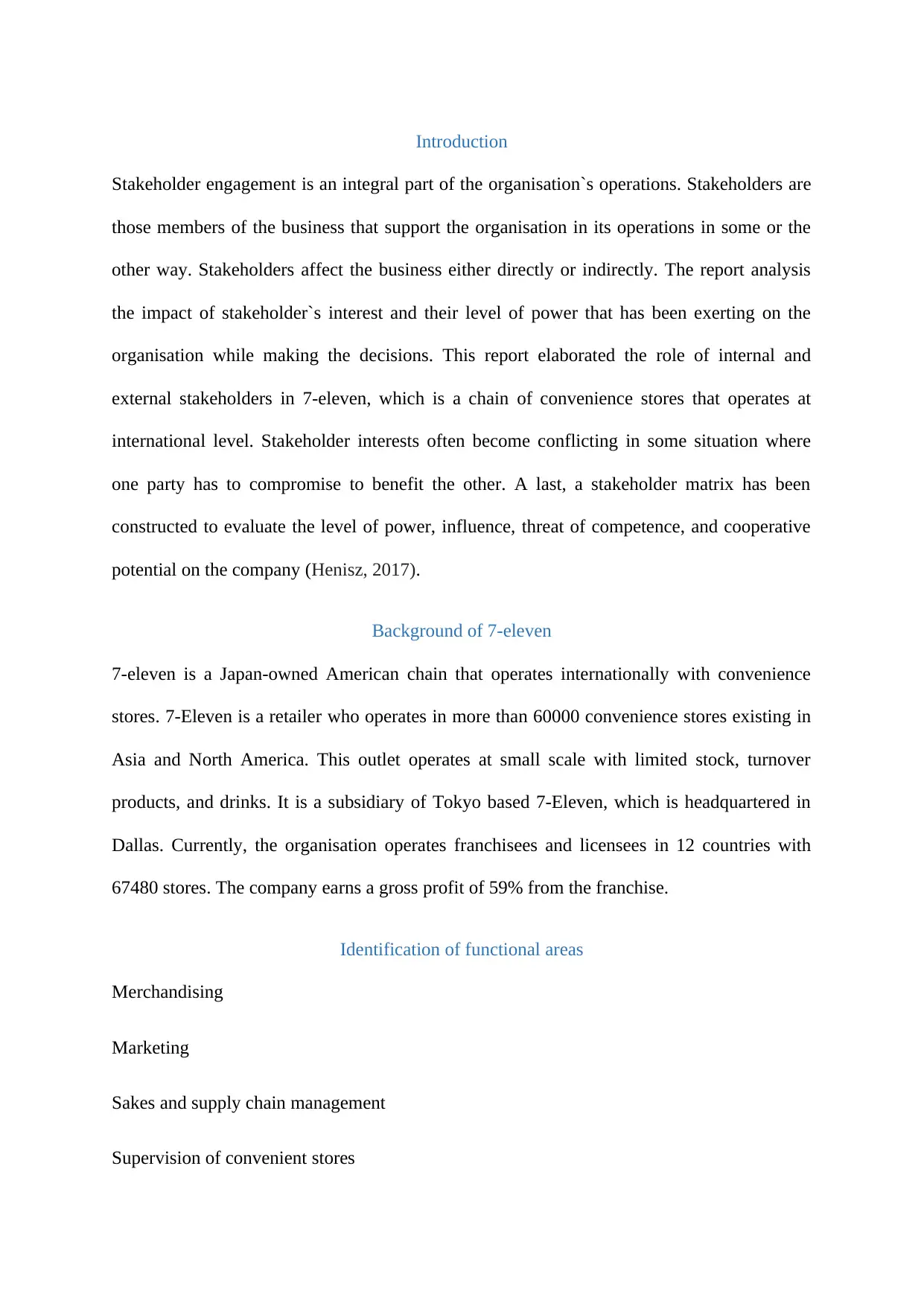
Introduction
Stakeholder engagement is an integral part of the organisation`s operations. Stakeholders are
those members of the business that support the organisation in its operations in some or the
other way. Stakeholders affect the business either directly or indirectly. The report analysis
the impact of stakeholder`s interest and their level of power that has been exerting on the
organisation while making the decisions. This report elaborated the role of internal and
external stakeholders in 7-eleven, which is a chain of convenience stores that operates at
international level. Stakeholder interests often become conflicting in some situation where
one party has to compromise to benefit the other. A last, a stakeholder matrix has been
constructed to evaluate the level of power, influence, threat of competence, and cooperative
potential on the company (Henisz, 2017).
Background of 7-eleven
7-eleven is a Japan-owned American chain that operates internationally with convenience
stores. 7-Eleven is a retailer who operates in more than 60000 convenience stores existing in
Asia and North America. This outlet operates at small scale with limited stock, turnover
products, and drinks. It is a subsidiary of Tokyo based 7-Eleven, which is headquartered in
Dallas. Currently, the organisation operates franchisees and licensees in 12 countries with
67480 stores. The company earns a gross profit of 59% from the franchise.
Identification of functional areas
Merchandising
Marketing
Sakes and supply chain management
Supervision of convenient stores
Stakeholder engagement is an integral part of the organisation`s operations. Stakeholders are
those members of the business that support the organisation in its operations in some or the
other way. Stakeholders affect the business either directly or indirectly. The report analysis
the impact of stakeholder`s interest and their level of power that has been exerting on the
organisation while making the decisions. This report elaborated the role of internal and
external stakeholders in 7-eleven, which is a chain of convenience stores that operates at
international level. Stakeholder interests often become conflicting in some situation where
one party has to compromise to benefit the other. A last, a stakeholder matrix has been
constructed to evaluate the level of power, influence, threat of competence, and cooperative
potential on the company (Henisz, 2017).
Background of 7-eleven
7-eleven is a Japan-owned American chain that operates internationally with convenience
stores. 7-Eleven is a retailer who operates in more than 60000 convenience stores existing in
Asia and North America. This outlet operates at small scale with limited stock, turnover
products, and drinks. It is a subsidiary of Tokyo based 7-Eleven, which is headquartered in
Dallas. Currently, the organisation operates franchisees and licensees in 12 countries with
67480 stores. The company earns a gross profit of 59% from the franchise.
Identification of functional areas
Merchandising
Marketing
Sakes and supply chain management
Supervision of convenient stores
Paraphrase This Document
Need a fresh take? Get an instant paraphrase of this document with our AI Paraphraser
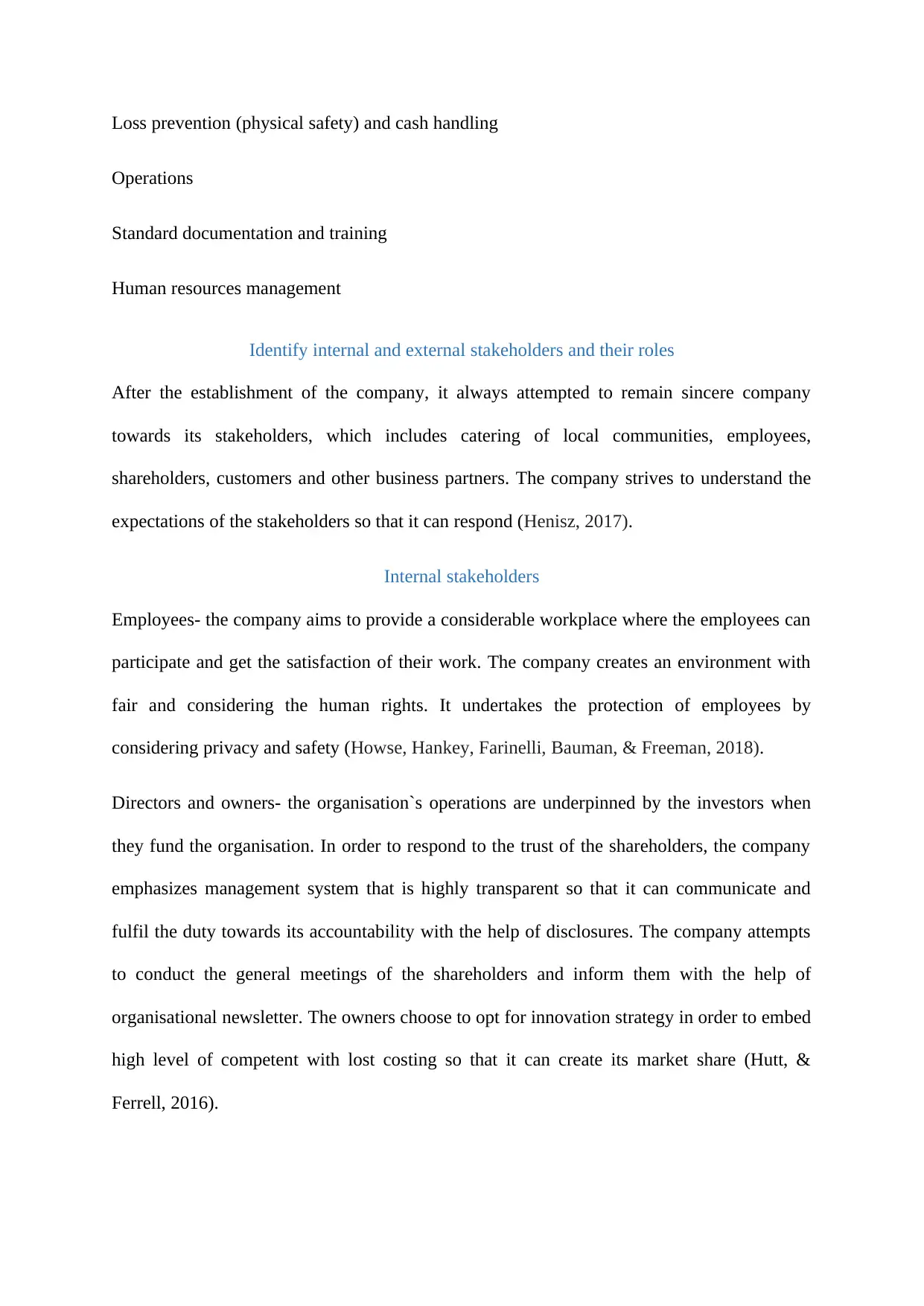
Loss prevention (physical safety) and cash handling
Operations
Standard documentation and training
Human resources management
Identify internal and external stakeholders and their roles
After the establishment of the company, it always attempted to remain sincere company
towards its stakeholders, which includes catering of local communities, employees,
shareholders, customers and other business partners. The company strives to understand the
expectations of the stakeholders so that it can respond (Henisz, 2017).
Internal stakeholders
Employees- the company aims to provide a considerable workplace where the employees can
participate and get the satisfaction of their work. The company creates an environment with
fair and considering the human rights. It undertakes the protection of employees by
considering privacy and safety (Howse, Hankey, Farinelli, Bauman, & Freeman, 2018).
Directors and owners- the organisation`s operations are underpinned by the investors when
they fund the organisation. In order to respond to the trust of the shareholders, the company
emphasizes management system that is highly transparent so that it can communicate and
fulfil the duty towards its accountability with the help of disclosures. The company attempts
to conduct the general meetings of the shareholders and inform them with the help of
organisational newsletter. The owners choose to opt for innovation strategy in order to embed
high level of competent with lost costing so that it can create its market share (Hutt, &
Ferrell, 2016).
Operations
Standard documentation and training
Human resources management
Identify internal and external stakeholders and their roles
After the establishment of the company, it always attempted to remain sincere company
towards its stakeholders, which includes catering of local communities, employees,
shareholders, customers and other business partners. The company strives to understand the
expectations of the stakeholders so that it can respond (Henisz, 2017).
Internal stakeholders
Employees- the company aims to provide a considerable workplace where the employees can
participate and get the satisfaction of their work. The company creates an environment with
fair and considering the human rights. It undertakes the protection of employees by
considering privacy and safety (Howse, Hankey, Farinelli, Bauman, & Freeman, 2018).
Directors and owners- the organisation`s operations are underpinned by the investors when
they fund the organisation. In order to respond to the trust of the shareholders, the company
emphasizes management system that is highly transparent so that it can communicate and
fulfil the duty towards its accountability with the help of disclosures. The company attempts
to conduct the general meetings of the shareholders and inform them with the help of
organisational newsletter. The owners choose to opt for innovation strategy in order to embed
high level of competent with lost costing so that it can create its market share (Hutt, &
Ferrell, 2016).
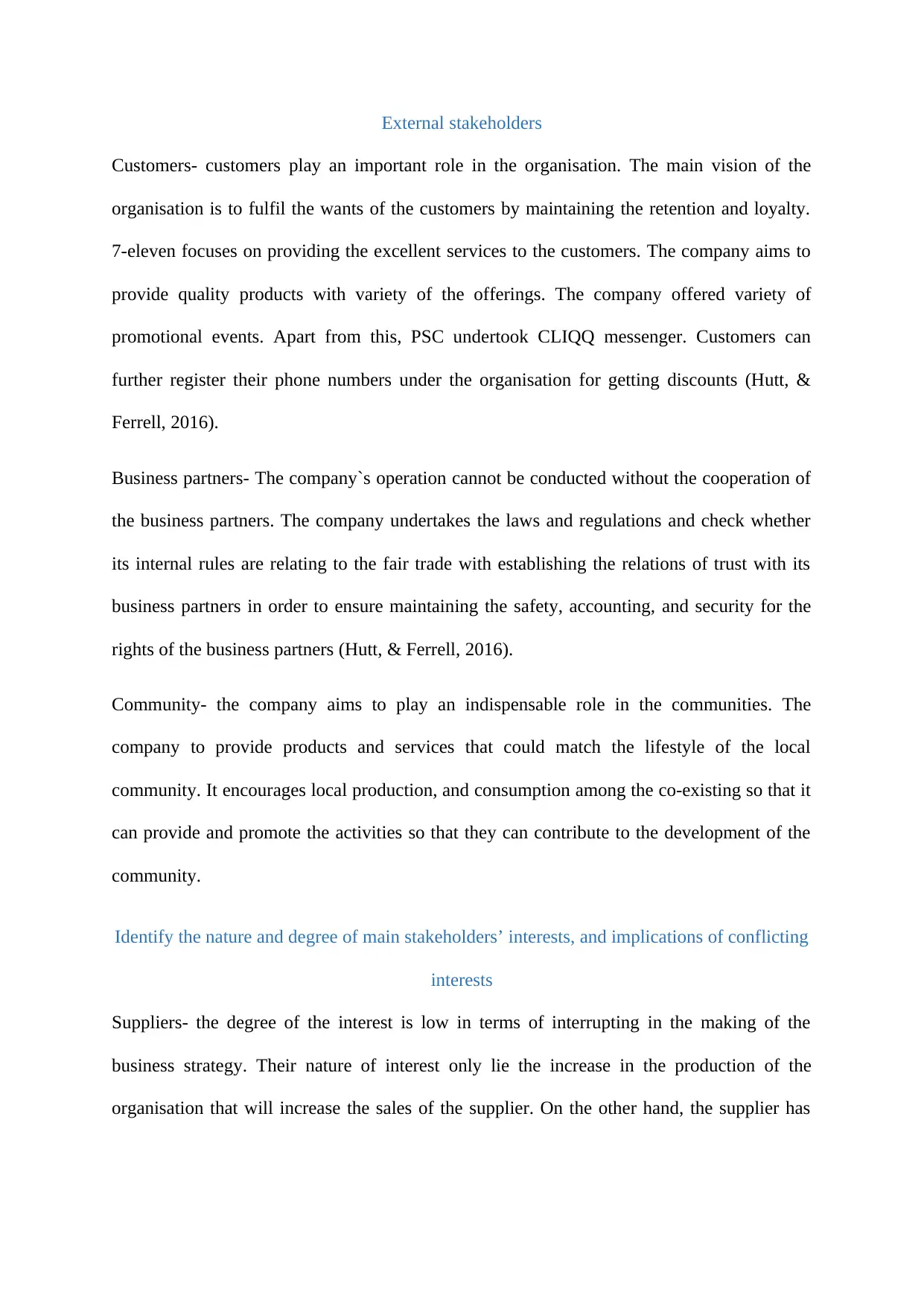
External stakeholders
Customers- customers play an important role in the organisation. The main vision of the
organisation is to fulfil the wants of the customers by maintaining the retention and loyalty.
7-eleven focuses on providing the excellent services to the customers. The company aims to
provide quality products with variety of the offerings. The company offered variety of
promotional events. Apart from this, PSC undertook CLIQQ messenger. Customers can
further register their phone numbers under the organisation for getting discounts (Hutt, &
Ferrell, 2016).
Business partners- The company`s operation cannot be conducted without the cooperation of
the business partners. The company undertakes the laws and regulations and check whether
its internal rules are relating to the fair trade with establishing the relations of trust with its
business partners in order to ensure maintaining the safety, accounting, and security for the
rights of the business partners (Hutt, & Ferrell, 2016).
Community- the company aims to play an indispensable role in the communities. The
company to provide products and services that could match the lifestyle of the local
community. It encourages local production, and consumption among the co-existing so that it
can provide and promote the activities so that they can contribute to the development of the
community.
Identify the nature and degree of main stakeholders’ interests, and implications of conflicting
interests
Suppliers- the degree of the interest is low in terms of interrupting in the making of the
business strategy. Their nature of interest only lie the increase in the production of the
organisation that will increase the sales of the supplier. On the other hand, the supplier has
Customers- customers play an important role in the organisation. The main vision of the
organisation is to fulfil the wants of the customers by maintaining the retention and loyalty.
7-eleven focuses on providing the excellent services to the customers. The company aims to
provide quality products with variety of the offerings. The company offered variety of
promotional events. Apart from this, PSC undertook CLIQQ messenger. Customers can
further register their phone numbers under the organisation for getting discounts (Hutt, &
Ferrell, 2016).
Business partners- The company`s operation cannot be conducted without the cooperation of
the business partners. The company undertakes the laws and regulations and check whether
its internal rules are relating to the fair trade with establishing the relations of trust with its
business partners in order to ensure maintaining the safety, accounting, and security for the
rights of the business partners (Hutt, & Ferrell, 2016).
Community- the company aims to play an indispensable role in the communities. The
company to provide products and services that could match the lifestyle of the local
community. It encourages local production, and consumption among the co-existing so that it
can provide and promote the activities so that they can contribute to the development of the
community.
Identify the nature and degree of main stakeholders’ interests, and implications of conflicting
interests
Suppliers- the degree of the interest is low in terms of interrupting in the making of the
business strategy. Their nature of interest only lie the increase in the production of the
organisation that will increase the sales of the supplier. On the other hand, the supplier has
⊘ This is a preview!⊘
Do you want full access?
Subscribe today to unlock all pages.

Trusted by 1+ million students worldwide
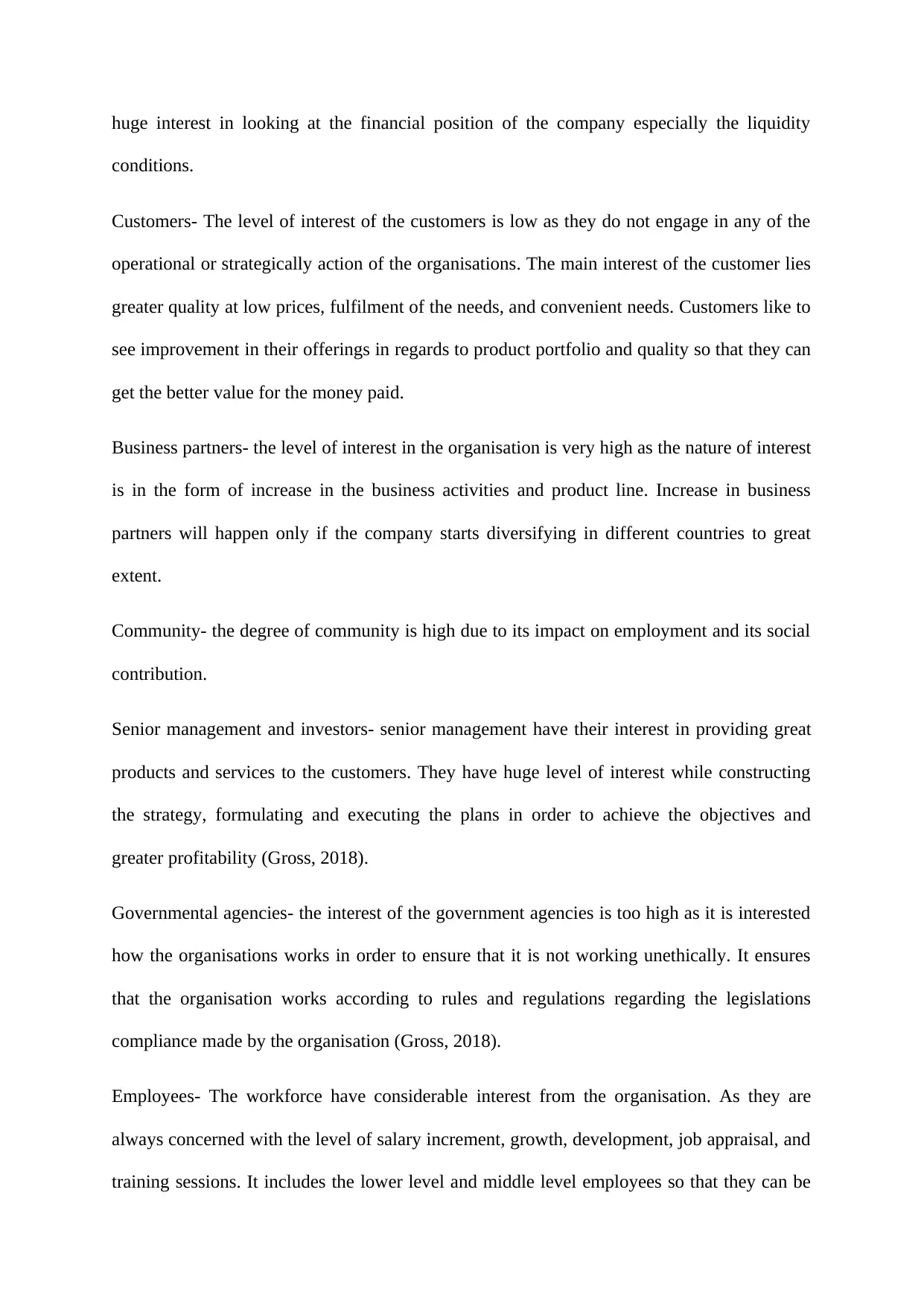
huge interest in looking at the financial position of the company especially the liquidity
conditions.
Customers- The level of interest of the customers is low as they do not engage in any of the
operational or strategically action of the organisations. The main interest of the customer lies
greater quality at low prices, fulfilment of the needs, and convenient needs. Customers like to
see improvement in their offerings in regards to product portfolio and quality so that they can
get the better value for the money paid.
Business partners- the level of interest in the organisation is very high as the nature of interest
is in the form of increase in the business activities and product line. Increase in business
partners will happen only if the company starts diversifying in different countries to great
extent.
Community- the degree of community is high due to its impact on employment and its social
contribution.
Senior management and investors- senior management have their interest in providing great
products and services to the customers. They have huge level of interest while constructing
the strategy, formulating and executing the plans in order to achieve the objectives and
greater profitability (Gross, 2018).
Governmental agencies- the interest of the government agencies is too high as it is interested
how the organisations works in order to ensure that it is not working unethically. It ensures
that the organisation works according to rules and regulations regarding the legislations
compliance made by the organisation (Gross, 2018).
Employees- The workforce have considerable interest from the organisation. As they are
always concerned with the level of salary increment, growth, development, job appraisal, and
training sessions. It includes the lower level and middle level employees so that they can be
conditions.
Customers- The level of interest of the customers is low as they do not engage in any of the
operational or strategically action of the organisations. The main interest of the customer lies
greater quality at low prices, fulfilment of the needs, and convenient needs. Customers like to
see improvement in their offerings in regards to product portfolio and quality so that they can
get the better value for the money paid.
Business partners- the level of interest in the organisation is very high as the nature of interest
is in the form of increase in the business activities and product line. Increase in business
partners will happen only if the company starts diversifying in different countries to great
extent.
Community- the degree of community is high due to its impact on employment and its social
contribution.
Senior management and investors- senior management have their interest in providing great
products and services to the customers. They have huge level of interest while constructing
the strategy, formulating and executing the plans in order to achieve the objectives and
greater profitability (Gross, 2018).
Governmental agencies- the interest of the government agencies is too high as it is interested
how the organisations works in order to ensure that it is not working unethically. It ensures
that the organisation works according to rules and regulations regarding the legislations
compliance made by the organisation (Gross, 2018).
Employees- The workforce have considerable interest from the organisation. As they are
always concerned with the level of salary increment, growth, development, job appraisal, and
training sessions. It includes the lower level and middle level employees so that they can be
Paraphrase This Document
Need a fresh take? Get an instant paraphrase of this document with our AI Paraphraser
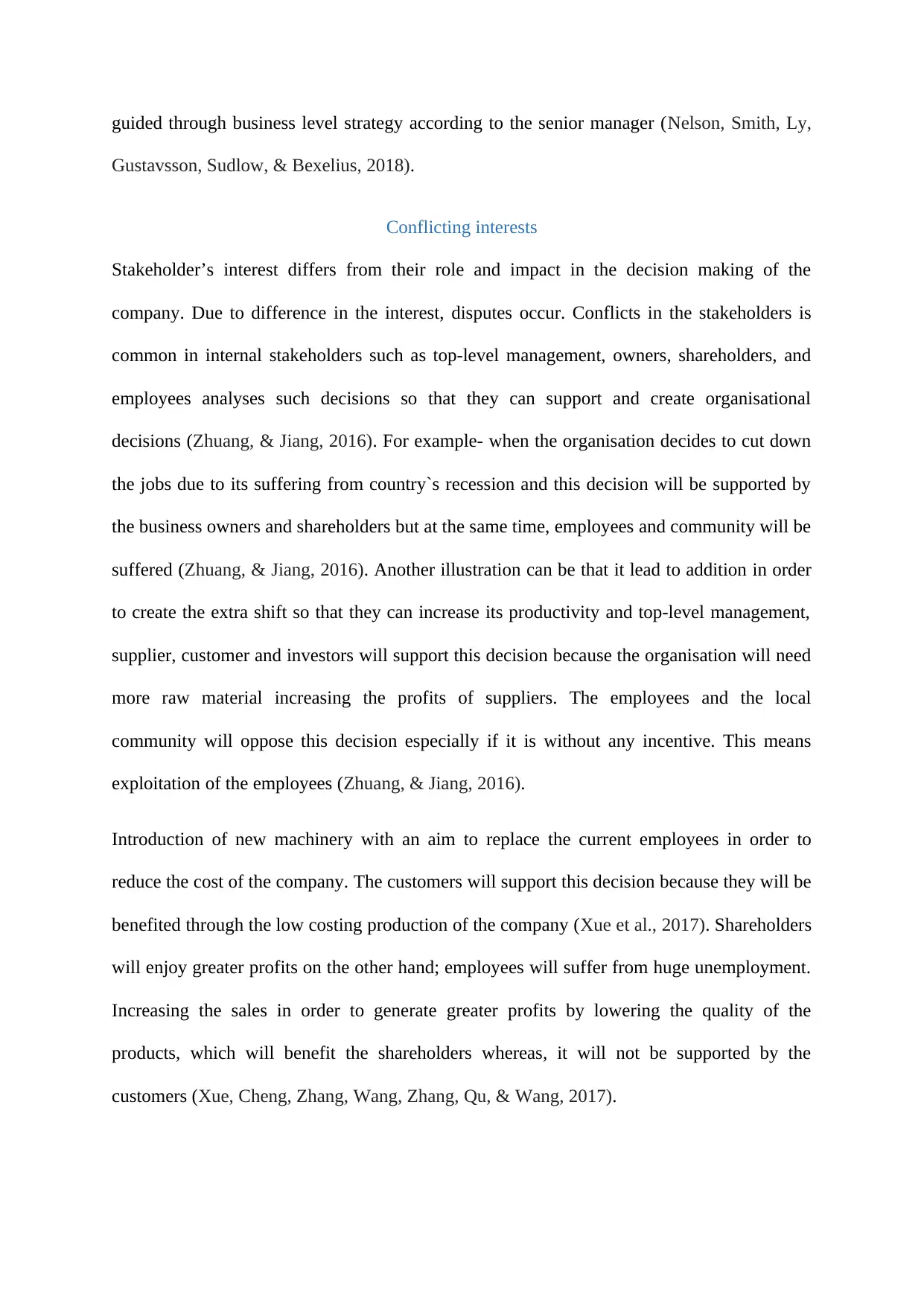
guided through business level strategy according to the senior manager (Nelson, Smith, Ly,
Gustavsson, Sudlow, & Bexelius, 2018).
Conflicting interests
Stakeholder’s interest differs from their role and impact in the decision making of the
company. Due to difference in the interest, disputes occur. Conflicts in the stakeholders is
common in internal stakeholders such as top-level management, owners, shareholders, and
employees analyses such decisions so that they can support and create organisational
decisions (Zhuang, & Jiang, 2016). For example- when the organisation decides to cut down
the jobs due to its suffering from country`s recession and this decision will be supported by
the business owners and shareholders but at the same time, employees and community will be
suffered (Zhuang, & Jiang, 2016). Another illustration can be that it lead to addition in order
to create the extra shift so that they can increase its productivity and top-level management,
supplier, customer and investors will support this decision because the organisation will need
more raw material increasing the profits of suppliers. The employees and the local
community will oppose this decision especially if it is without any incentive. This means
exploitation of the employees (Zhuang, & Jiang, 2016).
Introduction of new machinery with an aim to replace the current employees in order to
reduce the cost of the company. The customers will support this decision because they will be
benefited through the low costing production of the company (Xue et al., 2017). Shareholders
will enjoy greater profits on the other hand; employees will suffer from huge unemployment.
Increasing the sales in order to generate greater profits by lowering the quality of the
products, which will benefit the shareholders whereas, it will not be supported by the
customers (Xue, Cheng, Zhang, Wang, Zhang, Qu, & Wang, 2017).
Gustavsson, Sudlow, & Bexelius, 2018).
Conflicting interests
Stakeholder’s interest differs from their role and impact in the decision making of the
company. Due to difference in the interest, disputes occur. Conflicts in the stakeholders is
common in internal stakeholders such as top-level management, owners, shareholders, and
employees analyses such decisions so that they can support and create organisational
decisions (Zhuang, & Jiang, 2016). For example- when the organisation decides to cut down
the jobs due to its suffering from country`s recession and this decision will be supported by
the business owners and shareholders but at the same time, employees and community will be
suffered (Zhuang, & Jiang, 2016). Another illustration can be that it lead to addition in order
to create the extra shift so that they can increase its productivity and top-level management,
supplier, customer and investors will support this decision because the organisation will need
more raw material increasing the profits of suppliers. The employees and the local
community will oppose this decision especially if it is without any incentive. This means
exploitation of the employees (Zhuang, & Jiang, 2016).
Introduction of new machinery with an aim to replace the current employees in order to
reduce the cost of the company. The customers will support this decision because they will be
benefited through the low costing production of the company (Xue et al., 2017). Shareholders
will enjoy greater profits on the other hand; employees will suffer from huge unemployment.
Increasing the sales in order to generate greater profits by lowering the quality of the
products, which will benefit the shareholders whereas, it will not be supported by the
customers (Xue, Cheng, Zhang, Wang, Zhang, Qu, & Wang, 2017).
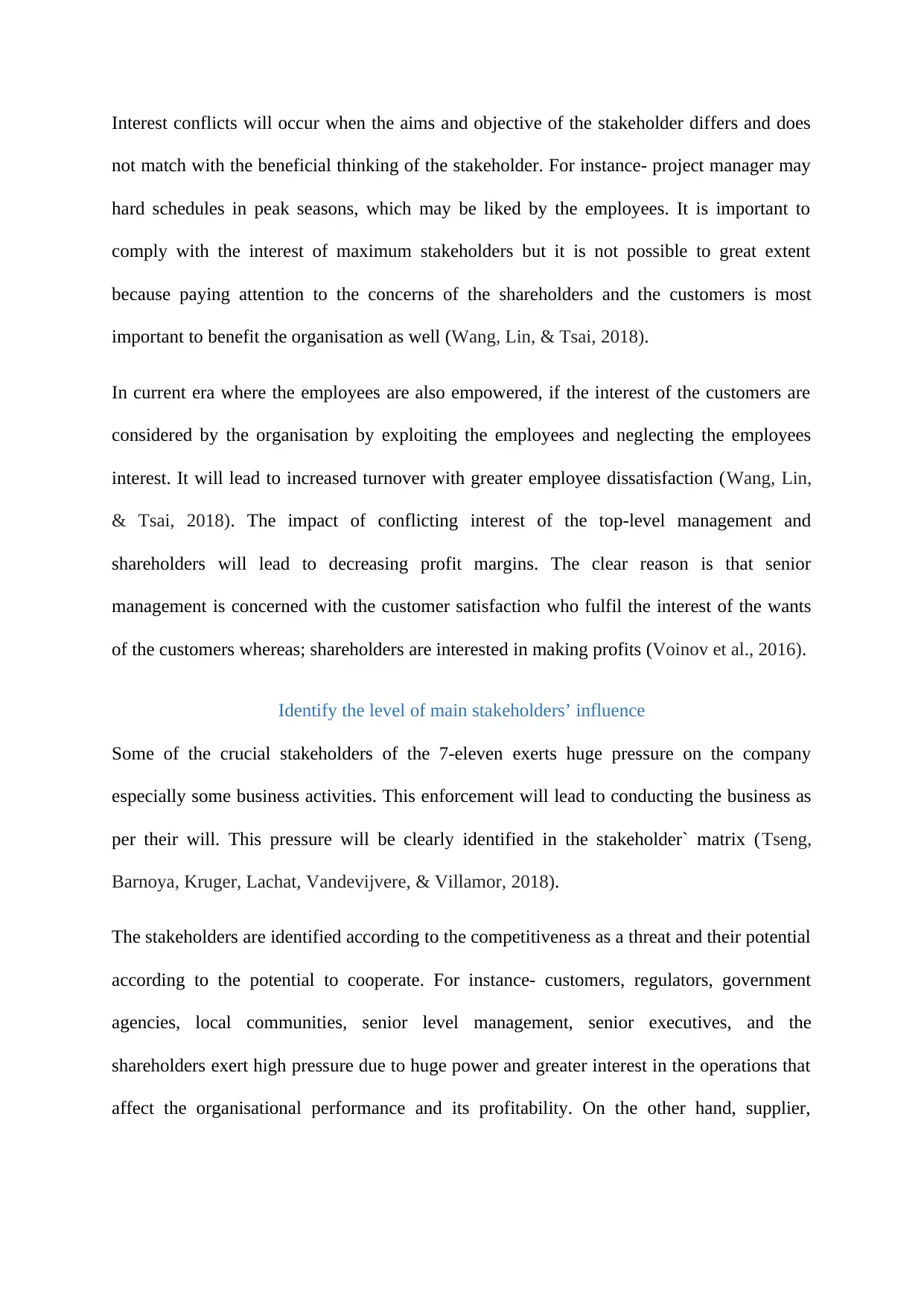
Interest conflicts will occur when the aims and objective of the stakeholder differs and does
not match with the beneficial thinking of the stakeholder. For instance- project manager may
hard schedules in peak seasons, which may be liked by the employees. It is important to
comply with the interest of maximum stakeholders but it is not possible to great extent
because paying attention to the concerns of the shareholders and the customers is most
important to benefit the organisation as well (Wang, Lin, & Tsai, 2018).
In current era where the employees are also empowered, if the interest of the customers are
considered by the organisation by exploiting the employees and neglecting the employees
interest. It will lead to increased turnover with greater employee dissatisfaction (Wang, Lin,
& Tsai, 2018). The impact of conflicting interest of the top-level management and
shareholders will lead to decreasing profit margins. The clear reason is that senior
management is concerned with the customer satisfaction who fulfil the interest of the wants
of the customers whereas; shareholders are interested in making profits (Voinov et al., 2016).
Identify the level of main stakeholders’ influence
Some of the crucial stakeholders of the 7-eleven exerts huge pressure on the company
especially some business activities. This enforcement will lead to conducting the business as
per their will. This pressure will be clearly identified in the stakeholder` matrix (Tseng,
Barnoya, Kruger, Lachat, Vandevijvere, & Villamor, 2018).
The stakeholders are identified according to the competitiveness as a threat and their potential
according to the potential to cooperate. For instance- customers, regulators, government
agencies, local communities, senior level management, senior executives, and the
shareholders exert high pressure due to huge power and greater interest in the operations that
affect the organisational performance and its profitability. On the other hand, supplier,
not match with the beneficial thinking of the stakeholder. For instance- project manager may
hard schedules in peak seasons, which may be liked by the employees. It is important to
comply with the interest of maximum stakeholders but it is not possible to great extent
because paying attention to the concerns of the shareholders and the customers is most
important to benefit the organisation as well (Wang, Lin, & Tsai, 2018).
In current era where the employees are also empowered, if the interest of the customers are
considered by the organisation by exploiting the employees and neglecting the employees
interest. It will lead to increased turnover with greater employee dissatisfaction (Wang, Lin,
& Tsai, 2018). The impact of conflicting interest of the top-level management and
shareholders will lead to decreasing profit margins. The clear reason is that senior
management is concerned with the customer satisfaction who fulfil the interest of the wants
of the customers whereas; shareholders are interested in making profits (Voinov et al., 2016).
Identify the level of main stakeholders’ influence
Some of the crucial stakeholders of the 7-eleven exerts huge pressure on the company
especially some business activities. This enforcement will lead to conducting the business as
per their will. This pressure will be clearly identified in the stakeholder` matrix (Tseng,
Barnoya, Kruger, Lachat, Vandevijvere, & Villamor, 2018).
The stakeholders are identified according to the competitiveness as a threat and their potential
according to the potential to cooperate. For instance- customers, regulators, government
agencies, local communities, senior level management, senior executives, and the
shareholders exert high pressure due to huge power and greater interest in the operations that
affect the organisational performance and its profitability. On the other hand, supplier,
⊘ This is a preview!⊘
Do you want full access?
Subscribe today to unlock all pages.

Trusted by 1+ million students worldwide
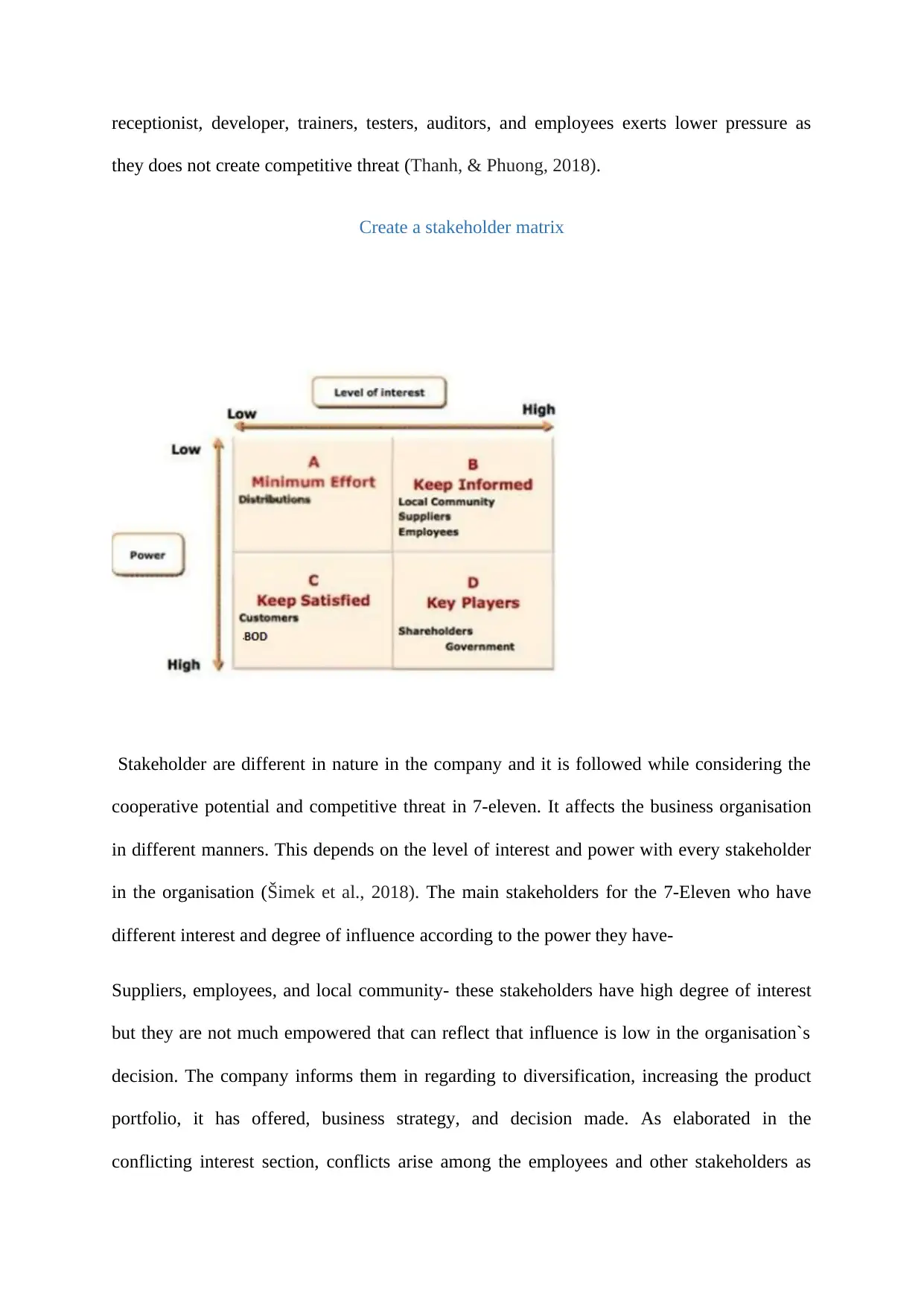
receptionist, developer, trainers, testers, auditors, and employees exerts lower pressure as
they does not create competitive threat (Thanh, & Phuong, 2018).
Create a stakeholder matrix
Stakeholder are different in nature in the company and it is followed while considering the
cooperative potential and competitive threat in 7-eleven. It affects the business organisation
in different manners. This depends on the level of interest and power with every stakeholder
in the organisation (Šimek et al., 2018). The main stakeholders for the 7-Eleven who have
different interest and degree of influence according to the power they have-
Suppliers, employees, and local community- these stakeholders have high degree of interest
but they are not much empowered that can reflect that influence is low in the organisation`s
decision. The company informs them in regarding to diversification, increasing the product
portfolio, it has offered, business strategy, and decision made. As elaborated in the
conflicting interest section, conflicts arise among the employees and other stakeholders as
they does not create competitive threat (Thanh, & Phuong, 2018).
Create a stakeholder matrix
Stakeholder are different in nature in the company and it is followed while considering the
cooperative potential and competitive threat in 7-eleven. It affects the business organisation
in different manners. This depends on the level of interest and power with every stakeholder
in the organisation (Šimek et al., 2018). The main stakeholders for the 7-Eleven who have
different interest and degree of influence according to the power they have-
Suppliers, employees, and local community- these stakeholders have high degree of interest
but they are not much empowered that can reflect that influence is low in the organisation`s
decision. The company informs them in regarding to diversification, increasing the product
portfolio, it has offered, business strategy, and decision made. As elaborated in the
conflicting interest section, conflicts arise among the employees and other stakeholders as
Paraphrase This Document
Need a fresh take? Get an instant paraphrase of this document with our AI Paraphraser
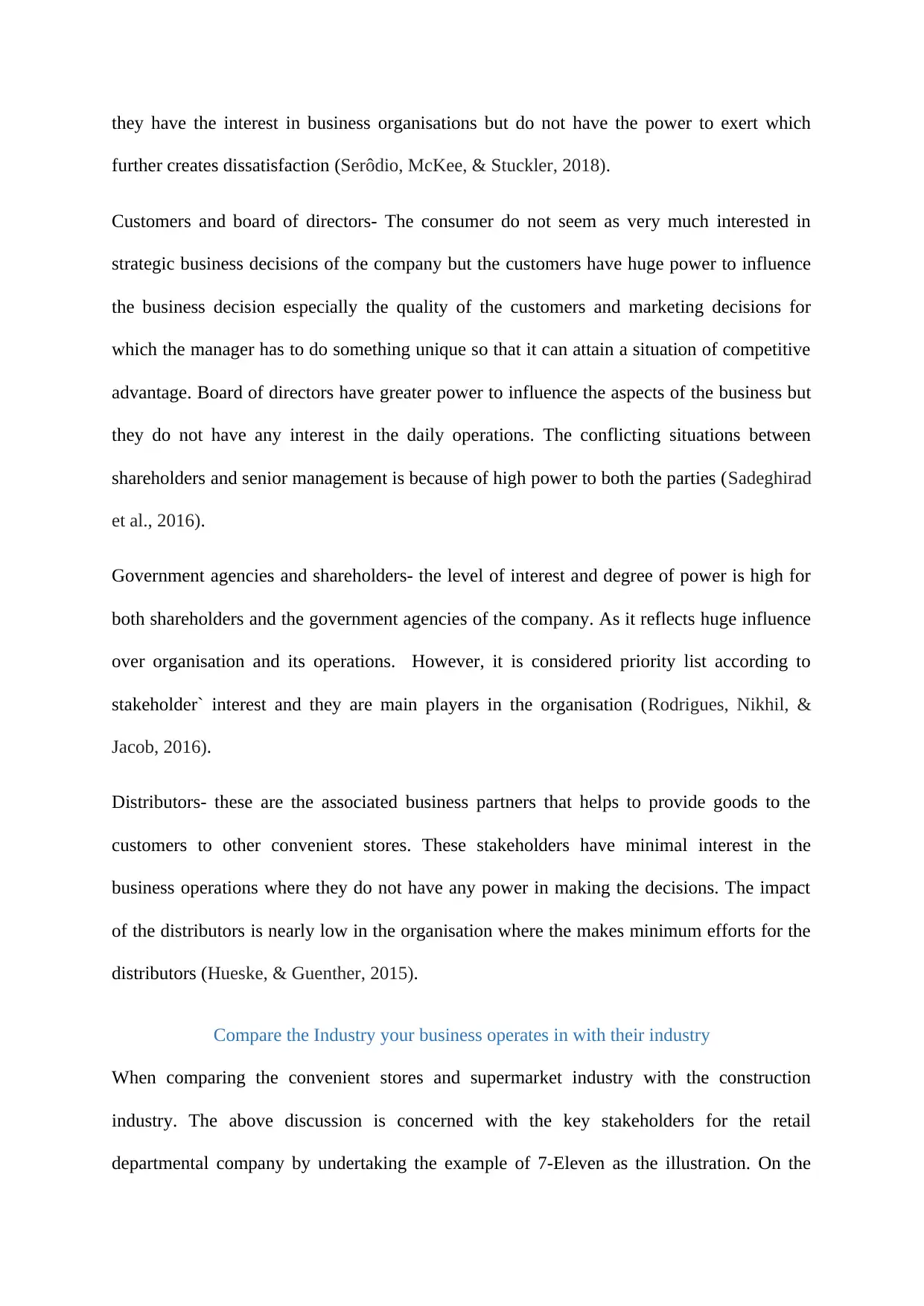
they have the interest in business organisations but do not have the power to exert which
further creates dissatisfaction (Serôdio, McKee, & Stuckler, 2018).
Customers and board of directors- The consumer do not seem as very much interested in
strategic business decisions of the company but the customers have huge power to influence
the business decision especially the quality of the customers and marketing decisions for
which the manager has to do something unique so that it can attain a situation of competitive
advantage. Board of directors have greater power to influence the aspects of the business but
they do not have any interest in the daily operations. The conflicting situations between
shareholders and senior management is because of high power to both the parties (Sadeghirad
et al., 2016).
Government agencies and shareholders- the level of interest and degree of power is high for
both shareholders and the government agencies of the company. As it reflects huge influence
over organisation and its operations. However, it is considered priority list according to
stakeholder` interest and they are main players in the organisation (Rodrigues, Nikhil, &
Jacob, 2016).
Distributors- these are the associated business partners that helps to provide goods to the
customers to other convenient stores. These stakeholders have minimal interest in the
business operations where they do not have any power in making the decisions. The impact
of the distributors is nearly low in the organisation where the makes minimum efforts for the
distributors (Hueske, & Guenther, 2015).
Compare the Industry your business operates in with their industry
When comparing the convenient stores and supermarket industry with the construction
industry. The above discussion is concerned with the key stakeholders for the retail
departmental company by undertaking the example of 7-Eleven as the illustration. On the
further creates dissatisfaction (Serôdio, McKee, & Stuckler, 2018).
Customers and board of directors- The consumer do not seem as very much interested in
strategic business decisions of the company but the customers have huge power to influence
the business decision especially the quality of the customers and marketing decisions for
which the manager has to do something unique so that it can attain a situation of competitive
advantage. Board of directors have greater power to influence the aspects of the business but
they do not have any interest in the daily operations. The conflicting situations between
shareholders and senior management is because of high power to both the parties (Sadeghirad
et al., 2016).
Government agencies and shareholders- the level of interest and degree of power is high for
both shareholders and the government agencies of the company. As it reflects huge influence
over organisation and its operations. However, it is considered priority list according to
stakeholder` interest and they are main players in the organisation (Rodrigues, Nikhil, &
Jacob, 2016).
Distributors- these are the associated business partners that helps to provide goods to the
customers to other convenient stores. These stakeholders have minimal interest in the
business operations where they do not have any power in making the decisions. The impact
of the distributors is nearly low in the organisation where the makes minimum efforts for the
distributors (Hueske, & Guenther, 2015).
Compare the Industry your business operates in with their industry
When comparing the convenient stores and supermarket industry with the construction
industry. The above discussion is concerned with the key stakeholders for the retail
departmental company by undertaking the example of 7-Eleven as the illustration. On the
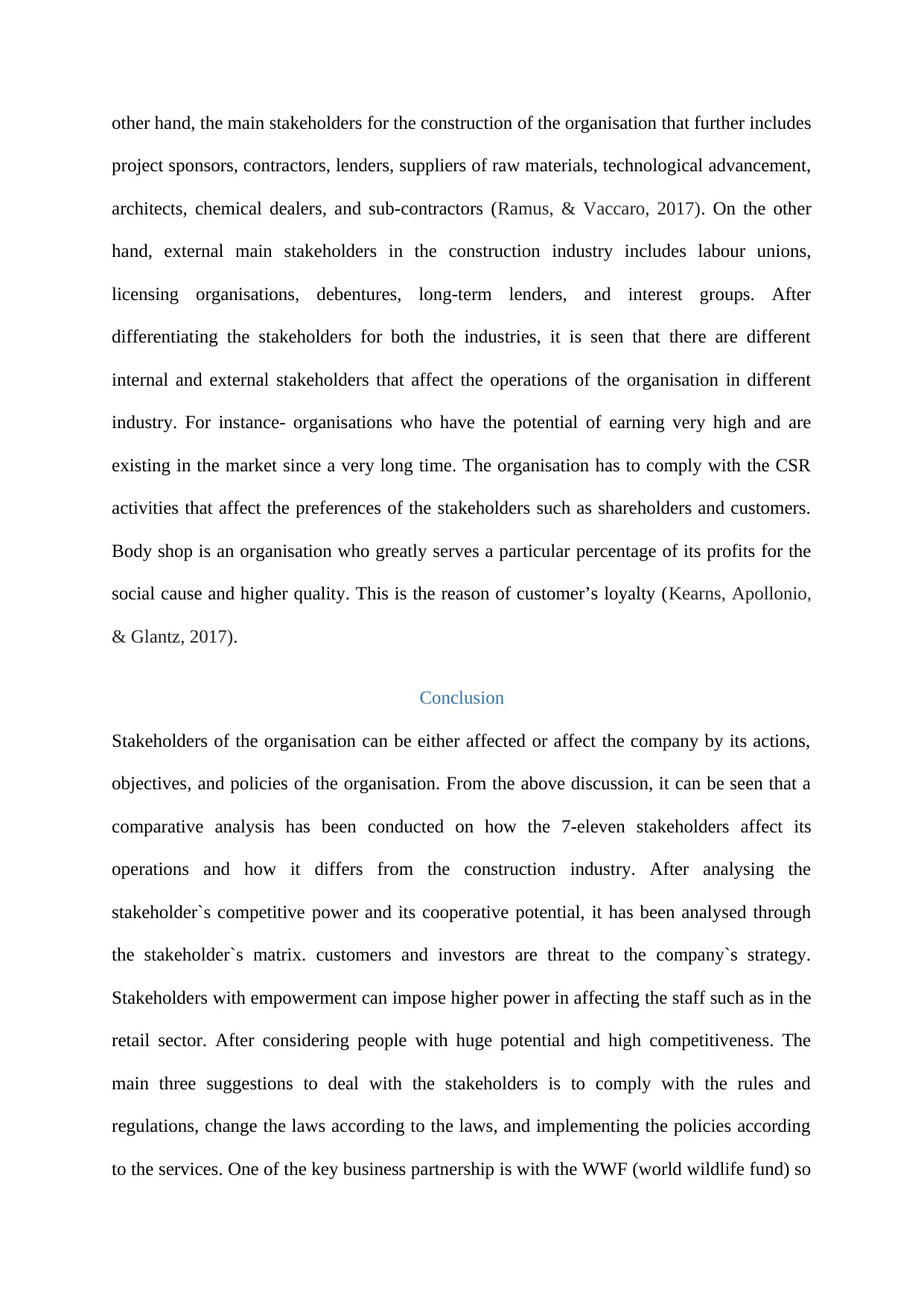
other hand, the main stakeholders for the construction of the organisation that further includes
project sponsors, contractors, lenders, suppliers of raw materials, technological advancement,
architects, chemical dealers, and sub-contractors (Ramus, & Vaccaro, 2017). On the other
hand, external main stakeholders in the construction industry includes labour unions,
licensing organisations, debentures, long-term lenders, and interest groups. After
differentiating the stakeholders for both the industries, it is seen that there are different
internal and external stakeholders that affect the operations of the organisation in different
industry. For instance- organisations who have the potential of earning very high and are
existing in the market since a very long time. The organisation has to comply with the CSR
activities that affect the preferences of the stakeholders such as shareholders and customers.
Body shop is an organisation who greatly serves a particular percentage of its profits for the
social cause and higher quality. This is the reason of customer’s loyalty (Kearns, Apollonio,
& Glantz, 2017).
Conclusion
Stakeholders of the organisation can be either affected or affect the company by its actions,
objectives, and policies of the organisation. From the above discussion, it can be seen that a
comparative analysis has been conducted on how the 7-eleven stakeholders affect its
operations and how it differs from the construction industry. After analysing the
stakeholder`s competitive power and its cooperative potential, it has been analysed through
the stakeholder`s matrix. customers and investors are threat to the company`s strategy.
Stakeholders with empowerment can impose higher power in affecting the staff such as in the
retail sector. After considering people with huge potential and high competitiveness. The
main three suggestions to deal with the stakeholders is to comply with the rules and
regulations, change the laws according to the laws, and implementing the policies according
to the services. One of the key business partnership is with the WWF (world wildlife fund) so
project sponsors, contractors, lenders, suppliers of raw materials, technological advancement,
architects, chemical dealers, and sub-contractors (Ramus, & Vaccaro, 2017). On the other
hand, external main stakeholders in the construction industry includes labour unions,
licensing organisations, debentures, long-term lenders, and interest groups. After
differentiating the stakeholders for both the industries, it is seen that there are different
internal and external stakeholders that affect the operations of the organisation in different
industry. For instance- organisations who have the potential of earning very high and are
existing in the market since a very long time. The organisation has to comply with the CSR
activities that affect the preferences of the stakeholders such as shareholders and customers.
Body shop is an organisation who greatly serves a particular percentage of its profits for the
social cause and higher quality. This is the reason of customer’s loyalty (Kearns, Apollonio,
& Glantz, 2017).
Conclusion
Stakeholders of the organisation can be either affected or affect the company by its actions,
objectives, and policies of the organisation. From the above discussion, it can be seen that a
comparative analysis has been conducted on how the 7-eleven stakeholders affect its
operations and how it differs from the construction industry. After analysing the
stakeholder`s competitive power and its cooperative potential, it has been analysed through
the stakeholder`s matrix. customers and investors are threat to the company`s strategy.
Stakeholders with empowerment can impose higher power in affecting the staff such as in the
retail sector. After considering people with huge potential and high competitiveness. The
main three suggestions to deal with the stakeholders is to comply with the rules and
regulations, change the laws according to the laws, and implementing the policies according
to the services. One of the key business partnership is with the WWF (world wildlife fund) so
⊘ This is a preview!⊘
Do you want full access?
Subscribe today to unlock all pages.

Trusted by 1+ million students worldwide
1 out of 16
Related Documents
Your All-in-One AI-Powered Toolkit for Academic Success.
+13062052269
info@desklib.com
Available 24*7 on WhatsApp / Email
![[object Object]](/_next/static/media/star-bottom.7253800d.svg)
Unlock your academic potential
Copyright © 2020–2025 A2Z Services. All Rights Reserved. Developed and managed by ZUCOL.





